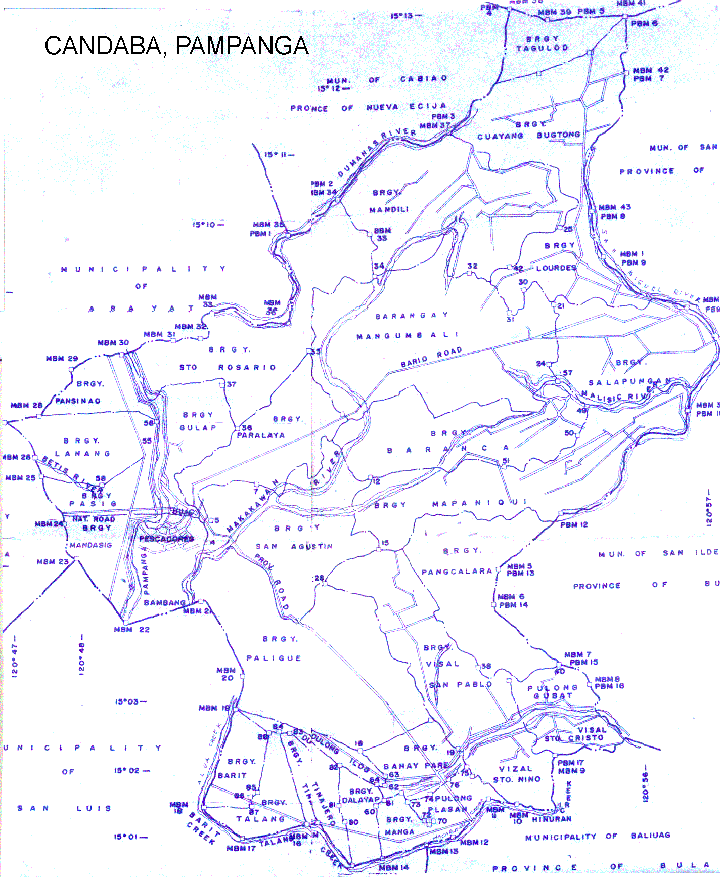The Home of Migratory Birds

Candaba, Pampanga is a Philippine town noted for its productive farmlands where sweet watermelons were made popular. It is known for its wide and scenic swamps, migratory birds, mudfish, catfish and many others. Candaba, once known as Candawe, has also become a major source of tilapia and duck eggs.
Basically a fishing and farming community, the place was administered by "datus" even as early as 1577. Topographically, Candaba, specially the swamps for what it became famous, represents the lowest point in Central Luzon.
The swamps are communal fishing grounds encompassing some 430 square kilometers of highly arable land.
Nowhere in Pampanga can one find any more fertile land than that of the Candaba swamps due to its sustained deposits of humus and decaying vegetable residues. Migrant wild ducks and various bird species escape winter winds from China and Siberia making Candaba their yearly sanctuary. Bird watching in the swamp is a tourist attraction.
The popular burong isda, a distinct Kapampangan fermented delicacy, is made from the best tilapia or mudfish as only Candaba can produce.
The Official Logo
 The official logo of Candaba is composed of three levels: the blue water, the green land and the bright sky. The blue color signifies purity, cleanliness and peace. The fish is the main aquatic produce of Candaba. The green color represents agriculture, the economic foundation of the municipality. The slices of red-meat watermelon or �pakwan� represent something that Candaba has been known for. They also represent the vision to make Candaba a leading source of agricultural products. The bright sky lit by the sun and stars of the Philippine flag represents love for the country and the flight of migratory birds signify unity in vision and action. The migratory birds, that inhabit the Candaba marsh, also represent the pursuit of environment-friendly development.
The official logo of Candaba is composed of three levels: the blue water, the green land and the bright sky. The blue color signifies purity, cleanliness and peace. The fish is the main aquatic produce of Candaba. The green color represents agriculture, the economic foundation of the municipality. The slices of red-meat watermelon or �pakwan� represent something that Candaba has been known for. They also represent the vision to make Candaba a leading source of agricultural products. The bright sky lit by the sun and stars of the Philippine flag represents love for the country and the flight of migratory birds signify unity in vision and action. The migratory birds, that inhabit the Candaba marsh, also represent the pursuit of environment-friendly development.
Population
- Household Population: 101,100 (2005)
- Number of Households: 16,211
The 33 Barangays of Candaba
The barangays of Candaba are Bahay Pare, Bambang, Barangca, Barit, Buas, Cuayang Bugtong, Dalayap, Gulap, Dulong Ilog, Lanang, Lourdes, Mangumbali, Mandasig, Mandili, Mangga, Mapaniqui, Paligue, Pangclara, Pansinao, Paralaya, Pasig, Pescadores, Pulong Gubat, Pulong Plazan, Salapungan, San Agustin, Santo Rosario, Tagulod, Talang, Tenejero, Vizal San Pablo, Vizal Santo Cristo, Vizal Santo Ni�o.
Candaba has developed into 3 regions because of its geographical characteristics. The Tagalog region comprising of 14 barangays shares border with Bulacan, the Capampangan region, comprising of 8 barangays lies farther north sharing boundaries with both Bulacan and Nueva Ecija, while the town center, the Poblacion with 11 barangays is separated by the vastness of the Candaba Swamp.
Total Agricultural Lands
Candaba has a total of 18,711 hectares of agricultural land with 5,433 farmers. During the rainy season it decreases to 12,425 hectares with 3,875 farmers.
Aside from rice, the other significant agricultural products are green corn involving some 332 hectares and 194 farmers and melon covering some 226 hectares with 105 farmers. About 60 hectares are used for commercial growing of various lowland vegetables. About 3,500 mango trees, both pico and Indian varieties, have been counted. Candaba remains the top rice producer in Pampanga.
Aquaculture
Candaba has 462 fishpond operators utilizing some 3,425 hectares of wetland. The rivers and their tributaries are inhabited by various species of fish that provide sources of income for marginal fishermen and trappers.
Tilapia is the main produce of the fishponds contributing significantly to making Pampanga the top tilapia producer of the country.
A fledgling ornamental fish industry exists in Candaba offering good prospects for the highly lucrative Koi breeding industry.
Domestic and Farm Animals
Laying duck population is already around 600,000 making Candaba the top producer of duck eggs in Pampanga. Chicken number around 20,000, quail about 50,000, hogs total about 9,000 heads, carabaos number about 900, cattle totals about 1,250, goats about 1,500. Candaba has 2,500 dogs and that is why the municipal government is strictly enforcing ban on stray dogs.
Mode of Transportation
Motorized tricycle is the main means of transportation for the residents. There are about 1,200 registered tricycle owner-operators distributed among the different barangay tricycle operators and drivers associations. The municipal government under Mayor Jerry Pelayo is making sure that appropriate laws and regualtions are being followed in their operation.
Other Businesses and Industries
There is a mix of small and medium scale businesses that are more progressive in the Tagalog and Capampangan regions owing to their nearness to the more developed towns in the nearby provinces of Bulacan and Nueva Ecija. The more progressive ones are agribusinesses catering to farmers and fishpond operators. Food processing is a growing industry.
Municipal Budget and Income
The municipal budget is dependent on the Internal Revenue Allotment of P59 Million it gets from the national government and its earnings of about P2.5 Million from various taxes and charges that Mayor Jerry Pelayo hopes to significantly increase in the coming years.